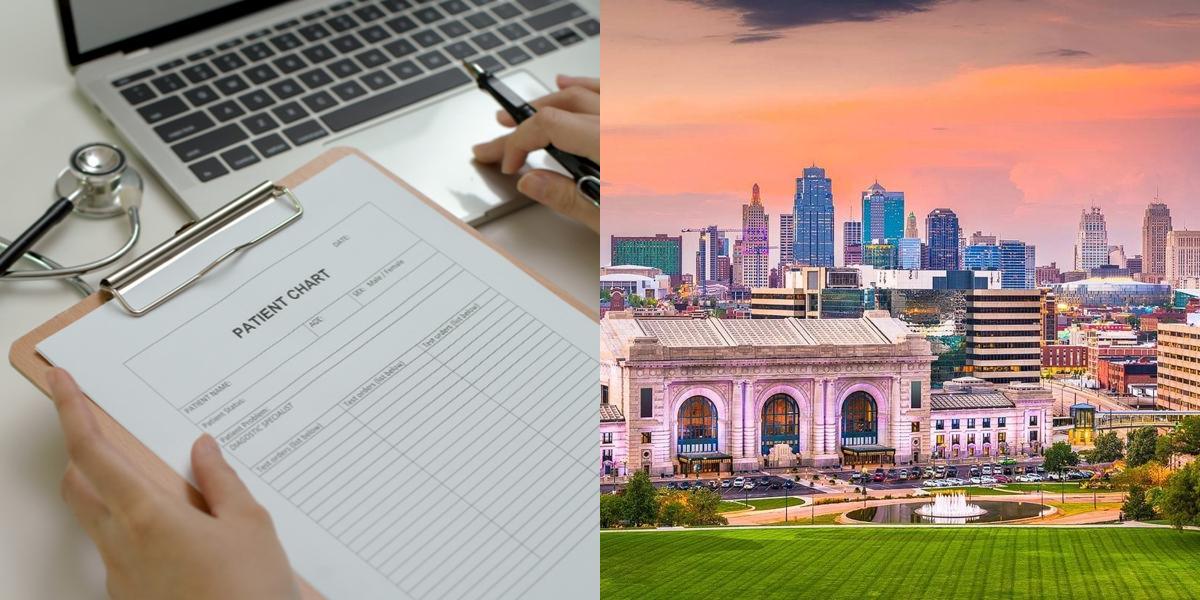How to Become a Medical Transcriptionist in Missouri

Want personalized recommendations?
Let's match you to the right program

Medical transcriptionists play a crucial role in the healthcare industry by transcribing medical reports and other important documentation. They are responsible for converting audio recordings of medical professionals into written format, ensuring accuracy and completeness. In addition to transcribing, they also edit and proofread the documents to ensure quality.
Article continues after recommendations
Recommended for you
Responsibilities of a Medical Transcriptionist
- Transcribing medical dictations into written documents
- Editing and proofreading transcriptions for accuracy and clarity
- Ensuring compliance with legal and ethical standards in healthcare documentation
- Maintaining patient confidentiality and data security
- Using specialized software and equipment for transcription purposes
- Collaborating with healthcare professionals to clarify dictations and resolve any discrepancies
Work Settings for Medical Transcriptionists
Medical transcriptionists can work in various settings, including:
-
Hospitals and clinics: Many medical transcriptionists work directly for hospitals and clinics, transcribing reports for the healthcare professionals working there.
-
Transcription services: Some medical transcriptionists work for specialized transcription services that provide transcription support to healthcare organizations.
-
Work from home: With advancements in technology, many medical transcriptionists have the flexibility to work remotely from their homes. This allows for a more flexible work schedule and eliminates the need for commuting.
How to Become a Medical Transcriptionist in Missouri?
To become a Medical Transcriptionist in Missouri, one must first complete the necessary education, typically a postsecondary certificate or diploma program. After obtaining the required certification, the individual can then search for job opportunities in the field to start earning a competitive salary.
Requirements to Become a Medical Transcriptionist in Missouri
To become a medical transcriptionist in Missouri, you typically need a combination of education and legal requirements. These include:
-
Education: Many employers prefer candidates with formal training in medical transcription. Vocational training programs and online courses provide the necessary knowledge and skills required for this profession.
-
Legal requirements: Some employers may require medical transcriptionists to obtain certification from a recognized professional organization, such as the Association for Healthcare Documentation Integrity (AHDI).
Exploring a Career in Medical Transcriptionist Outside Missouri
If you've been inspired to follow the path of a Medical Transcriptionist but geography isn't on your side, worry not. Your aspiration to become a Medical Transcriptionist is within reach in Alaska, Michigan. For those who don't find these options feasible, Dreambound enables you to effortlessly find and evaluate Medical Transcriptionist classes by simply search by zip code. Armed with determination and Dreambound, anyone, anywhere, can achieve a career in healthcare.
Get courses selected just for you
Try our powerful search engine
Article continues after recommendations
More recommendations for you
How do I get my Medical Transcriptionist certification?
If you are interested in pursuing a career as a medical transcriptionist, obtaining certification is a great way to enhance your credentials and increase your chances of landing a job in the field. Certification demonstrates your competency in medical transcription and can give you a competitive edge over other job applicants. Here are the steps you can take to get your medical transcriptionist certification:
-
Research certification options: There are several certification programs available for medical transcriptionists. The most recognized and respected certifications in the field are offered by the Association for Healthcare Documentation Integrity (AHDI). AHDI offers two main certifications: the Registered Healthcare Documentation Specialist (RHDS) and the Certified Healthcare Documentation Specialist (CHDS). Research each certification option to determine which one best suits your career goals and aspirations.
-
Meet the eligibility requirements: Before you can apply for certification, you will need to meet certain eligibility requirements. These requirements typically include a minimum level of education, such as a high school diploma or equivalent, and completion of a medical transcription training program. Some certification programs may also require you to have a certain amount of work experience in the field.
-
Complete a medical transcription training program: To gain the necessary knowledge and skills required for certification, it is recommended to complete a medical transcription training program. These programs are often offered by community colleges, vocational schools, and online education providers. Look for programs that are accredited by AHDI or other recognized accrediting bodies to ensure the quality of education you receive.
-
Prepare for the certification exam: Once you have completed a medical transcription training program, you will need to prepare for the certification exam. The exam typically consists of multiple-choice questions that assess your knowledge and understanding of medical terminology, anatomy, physiology, grammar, punctuation, and transcription guidelines. Study resources, such as textbooks, practice exams, and online courses, can help you prepare for the exam.
-
Schedule and take the certification exam: After you feel adequately prepared, you can schedule and take the certification exam. AHDI offers the RHDS and CHDS exams through proctored testing centers located throughout the United States, including in Missouri. The exams are computer-based and typically last around three hours. Passing the exam demonstrates your proficiency in medical transcription and qualifies you for certification.
-
Maintain your certification: Once you have obtained your medical transcriptionist certification, it is important to maintain it by meeting any continuing education requirements. Certification organizations, such as AHDI, often require certified professionals to complete a certain number of continuing education units (CEUs) every few years to ensure they stay up to date with advancements in the field. This may involve attending conferences, taking online courses, or participating in other educational activities.
By following these steps, you can obtain your medical transcriptionist certification and position yourself as a qualified and competent professional in the field.
How do I get a job as a Medical Transcriptionist?
Now that you have obtained your medical transcriptionist certification, you may be wondering how to secure a job in the field. Here are some steps you can take to increase your chances of finding employment as a medical transcriptionist:
-
Create a professional resume: Start by creating a professional resume that highlights your certification, education, and any relevant work experience or skills. Tailor your resume to the specific job you are applying for by emphasizing your medical transcription expertise and any additional qualifications that may be relevant to the position.
-
Network with professionals in the field: Networking can be a valuable tool in finding job opportunities. Reach out to professionals in the medical transcription industry, such as AHDI members or local transcriptionist associations, to connect with individuals who may have job leads or be able to provide advice or guidance. Attend industry events, join online forums or discussion groups, and engage in conversations with other professionals in the field.
-
Apply for medical transcriptionist positions: Look for job postings for medical transcriptionist positions in your area, including hospitals, clinics, transcription companies, and healthcare facilities. Online job boards, such as Indeed or LinkedIn, can be a great resource for finding job opportunities. Apply to positions that align with your skills, experience, and career goals.
-
Prepare for job interviews: Once you start receiving interview invitations, it is important to prepare for the interviews to increase your chances of success. Research the company or organization you are interviewing with, familiarize yourself with their transcription processes and requirements, and practice answering common interview questions. Be prepared to discuss your certification, education, work experience, and any other qualifications that make you a strong candidate for the position.
-
Demonstrate your skills: During the interview process, you may be asked to demonstrate your transcription skills. Be prepared to provide samples of your work or complete a transcription test to showcase your abilities. Accuracy, attention to detail, and proficiency in medical terminology and transcription guidelines are key skills that employers look for in medical transcriptionists.
-
Consider gaining experience through freelance work: If you are struggling to find a full-time position as a medical transcriptionist, consider gaining experience through freelance work. Many transcription companies and healthcare facilities offer freelance or contract opportunities for medical transcriptionists. This can be a great way to build your portfolio, gain experience, and make connections in the industry.
By following these steps and staying persistent in your job search, you can increase your chances of finding a job as a medical transcriptionist.
Career Paths and Opportunities after Becoming a Medical Transcriptionist
Becoming a certified medical transcriptionist opens up various career paths and opportunities in the healthcare industry. Here are some potential career paths you can consider after becoming a medical transcriptionist:
-
Medical Transcription Supervisor/Manager: With experience and advanced skills, you can progress to a supervisory or managerial role within a medical transcription department. In this role, you would oversee a team of transcriptionists, ensure quality and accuracy in transcriptions, and manage workflow and deadlines.
-
Medical Transcription Editor: As a medical transcription editor, you would review and edit transcriptions completed by other transcriptionists for accuracy, grammar, punctuation, and adherence to transcription guidelines. This role requires a strong command of medical terminology and transcription standards.
-
Medical Coding Specialist: Medical transcriptionists with a strong understanding of medical terminology and coding guidelines can transition into medical coding. Medical coding involves assigning codes to patient diagnoses and procedures for billing and reimbursement purposes. Additional training and certification in medical coding may be required.
-
Healthcare Documentation Quality Assurance: Quality assurance professionals in healthcare documentation ensure that transcriptions meet industry standards and are accurate and complete. They review transcriptions, provide feedback and training to transcriptionists, and develop and implement quality improvement initiatives.
-
Medical Transcription Trainer/Educator: If you enjoy teaching and sharing your knowledge, you can explore opportunities as a medical transcription trainer or educator. In this role, you would develop and deliver training programs for aspiring medical transcriptionists, update existing training materials, and provide ongoing support and guidance to students.
-
Medical Transcription Entrepreneur: With the necessary experience and skills, you can start your own medical transcription business. As an entrepreneur, you would provide transcription services to healthcare facilities, manage a team of transcriptionists, and handle business operations such as marketing, client acquisition, and billing.
These are just a few examples of the career paths and opportunities available to certified medical transcriptionists. The healthcare industry is constantly evolving, and there may be new roles and opportunities emerging that align with your skills and interests. Continuously expanding your knowledge, staying updated with industry trends, and networking with professionals in the field can help you discover and pursue new career paths.
Final Thoughts
Becoming a certified medical transcriptionist can open up a world of opportunities in the healthcare industry. By following the steps to obtain certification, networking with professionals in the field, and actively seeking job opportunities, you can increase your chances of finding a job as a medical transcriptionist. Once you have gained experience in the field, there are various career paths and opportunities you can explore. Whether you choose to advance within the medical transcription field or transition into related roles such as medical coding or quality assurance, your certification and experience as a medical transcriptionist will serve as a strong foundation for your career. Continuously staying updated with industry advancements and expanding your skills can help you thrive in this dynamic and rewarding profession.
Dreambound offers a window into various career paths, so if you're considering a shift in your career, browse through these articles:

Harold Roldan is a Growth team member at Dreambound. With a background in IT, he works with data and automation to improve team efficiency and workflows. He spends his free time playing musical instruments or studying data, computers, and technology.



